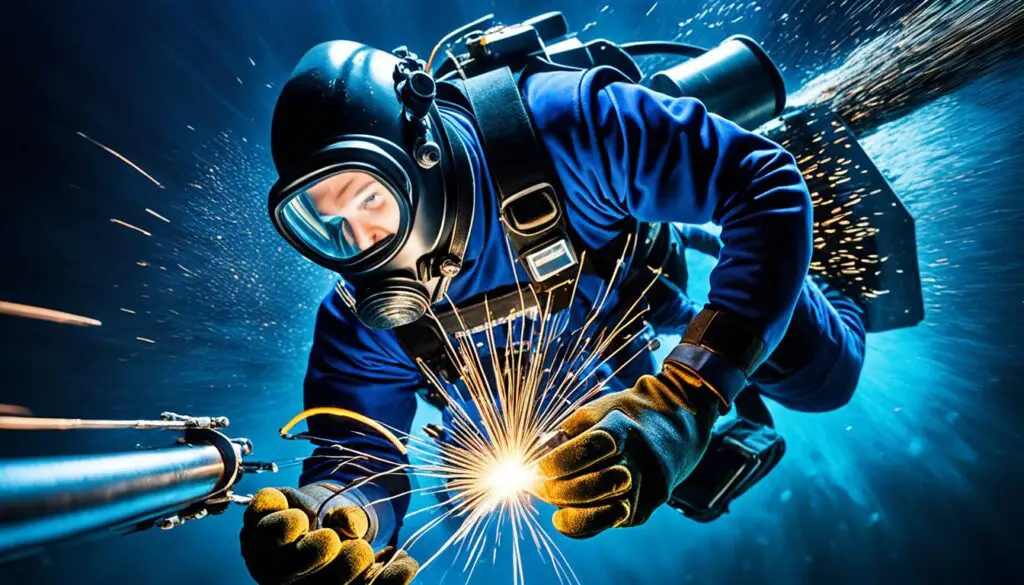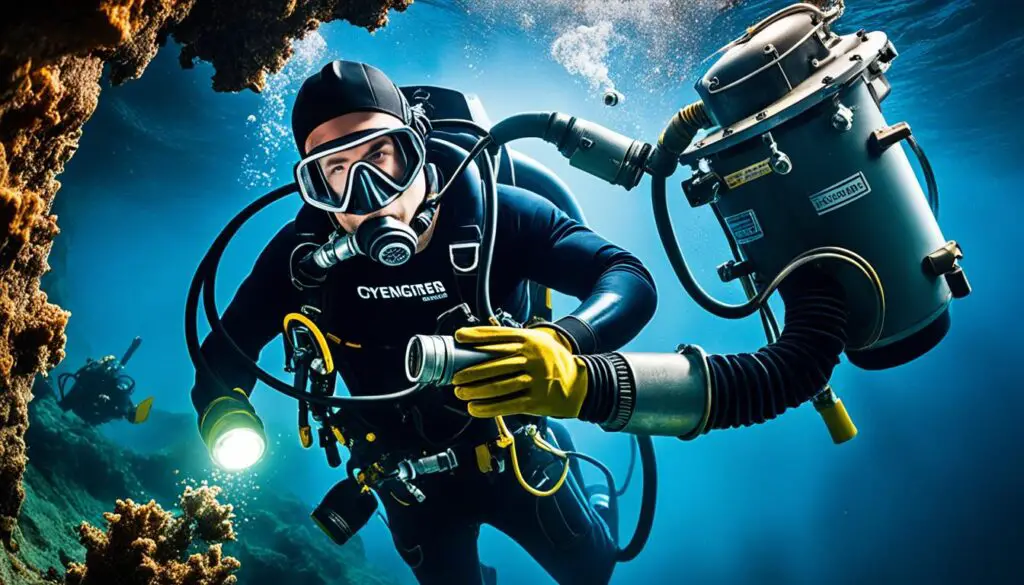Underwater welding, also known as wet welding, is a fascinating and high-skill niche that combines the precision of welding with the risks and challenges of working beneath the waves. It involves joining metal structures or repairing underwater infrastructure without the need for dry conditions. This unique profession requires specialized training and equipment to ensure the safety and success of welders working in underwater environments.
Various techniques and precautions are employed in underwater welding to overcome the difficulties posed by water pressure, limited visibility, and the corrosive nature of the marine environment. It is an essential skill in industries such as offshore construction, oil and gas, salvage operations, and ship maintenance.
Key Takeaways:
- Underwater welding, also known as wet welding, combines precision welding with the challenges of working in aquatic environments.
- Specialized training and equipment are necessary for underwater welders to safely perform their duties.
- Underwater welding is crucial in industries such as offshore construction, oil and gas, salvage operations, and ship maintenance.
- Techniques like wet welding and the use of dive support vessels are employed in this profession.
- Risks associated with underwater welding include electric shock, nitrogen narcosis, and decompression sickness.
The Techniques of Underwater Welding
Underwater welding encompasses two main techniques: dry welding and wet welding. While dry welding involves creating a sealed chamber around the welding area to keep the water out, wet welding is performed directly in the underwater environment.
Wet welding is the more commonly used method due to its flexibility and cost-effectiveness in various underwater applications. This technique utilizes a special electrode that generates a gaseous shield around the weld, effectively preventing water from interfering with the welding process.
Dive support vessels play a crucial role in underwater welding operations, serving as platforms that provide the necessary equipment, tools, and support divers. These vessels ensure a safe and efficient work environment for underwater welders. They are equipped with all the essential tools and machinery required for successful underwater welding, including welding equipment, power supplies, cutting tools, and safety gear.
Underwater welders undergo rigorous training programs that encompass both diving skills and welding techniques. This comprehensive training equips them with the necessary knowledge and skills to carry out successful underwater welding operations.
Comparison and Benefits of Wet Welding Techniques:
Wet welding techniques offer several advantages compared to dry welding:
- Flexibility: Wet welding allows welders to work in various underwater environments, regardless of water depth or location. This versatility is particularly valuable in offshore construction, ship maintenance, and repair operations.
- Cost-effectiveness: Wet welding eliminates the need for expensive and time-consuming dry chamber setups, making it a more cost-effective solution for underwater welding projects.
- Efficiency: Since wet welding is performed directly in the water, it saves time by eliminating the need for welders to transition between dry and wet conditions.
- Accessibility: Wet welding enables welders to perform repairs and maintenance on structures that would be otherwise challenging or impossible to access using dry welding methods.
Example of a Dive Support Vessel for Underwater Welding Operations:
| Equipment/Tools | Details |
|---|---|
| Diving Equipment | A full range of diving equipment, including diving suits, helmets, and breathing apparatus, to ensure diver safety and comfort during underwater welding. |
| Welding Equipment | Specialized underwater welding equipment, such as welding machines, electrodes, cables, and protective gear, to facilitate the welding process in the underwater environment. |
| Power Supplies | Generators and power distribution systems to provide a stable and reliable power source for underwater welding operations. |
| Cutting Tools | A variety of cutting tools, including underwater plasma cutters and underwater cutting torches, for preparing surfaces and making precise cuts during underwater welding projects. |
| Support Divers | Experienced support divers who assist underwater welders during operations, ensuring their safety and providing additional assistance as required. |

Underwater welding is a complex and demanding occupation that requires the mastery of specialized techniques and training. The combination of wet welding techniques and dive support vessels enables underwater welders to carry out essential maintenance, repairs, and construction projects in challenging underwater environments.
The Risks and Precautions in Underwater Welding
Underwater welding, despite being a remarkable profession, comes with its fair share of risks and hazards that welders must be well-prepared to confront and mitigate. The foremost and most menacing danger in this line of work is the risk of electrocution, as water is an excellent conductor of electricity. To minimize the chances of such an incident, welders need to exercise extra caution and implement proper safety measures.
One crucial safety practice is the insulation of equipment and electrical cables used in underwater welding. Adequate insulation helps prevent electrical current from coming into contact with surrounding water and reduces the risk of electric shock. Additionally, welders must pay close attention to grounding, ensuring a safe discharge of excess current to minimize the potential for electrocution.
Aside from electrocution, there are other hazards that underwater welders need to address. When operating at great depths, there is a risk of nitrogen narcosis, a condition that can impair cognitive function and decision-making abilities. This hazard highlights the crucial importance of remaining vigilant and focused during underwater welding operations.
Another risk associated with deep-sea welding is decompression sickness. Ascending too quickly from deep dives can result in the formation of nitrogen bubbles in the body tissues, which can lead to severe and even life-threatening symptoms. To combat this risk, underwater welders adhere to strict decompression schedules and utilize specialized deep-sea diving equipment, such as diving suits and helmets with integrated decompression chambers.
Overall, while underwater welding offers exciting opportunities, it is essential to prioritize safety at all times. The implementation of rigorous safety protocols, specialized equipment, and continuous education and training are critical in minimizing the risks and ensuring the well-being of underwater welders.

Quotes:
“Safety is paramount in the field of underwater welding. Investing in proper training, staying updated on industry best practices, and understanding the hazards involved are vital for the welfare of welders.” – John Smith, Certified Underwater Welding Instructor
Precautions in Underwater Welding:
- Ensure proper insulation of equipment and electrical cables to minimize the risk of electrocution.
- Pay careful attention to grounding to provide a safe path for excess current.
- Follow strict decompression schedules to avoid decompression sickness.
- Utilize specialized deep-sea diving equipment, including protective suits and helmets with integrated decompression chambers.
- Stay updated on safety guidelines and industry best practices to mitigate risks.
Conclusion
Underwater welding is a demanding and unique profession that requires a combination of technical skill, physical endurance, and adaptability. The individuals involved in this field undergo extensive training to master the complex techniques and safety measures necessary for success.
This profession plays a crucial role in maintaining and repairing various underwater structures and infrastructure, such as offshore installations, underwater pipelines, and shipyards. Underwater welders contribute to the development and longevity of these underwater assets, ensuring their functionality and safety.
The underwater welding profession continues to evolve and advance with ongoing research and innovation in equipment, techniques, and safety practices. Efforts are being made to improve the efficiency and safety of underwater welding operations, further enhancing the contributions of these skilled professionals to the maintenance and development of underwater infrastructure.
FAQ
What is underwater welding?
Underwater welding, also known as wet welding, is the process of joining metal structures or repairing underwater infrastructure without the need for dry conditions. It is a specialized profession that requires specialized training and equipment to ensure the safety and success of welders working in underwater environments.
How does wet welding differ from dry welding?
Wet welding is performed directly in the underwater environment, while dry welding involves creating a sealed chamber around the welding area to keep the water out. Wet welding is more commonly used due to its flexibility and cost-effectiveness.
What techniques are used in underwater welding?
Underwater welding employs two main techniques: dry welding and wet welding. Wet welding, which is more commonly used, utilizes a special electrode that generates a gaseous shield around the weld to prevent water from interfering with the welding process.
What is a dive support vessel?
A dive support vessel is a platform used for underwater welding operations. It provides the necessary equipment, tools, and support divers to ensure a safe and efficient work environment.
What are the risks involved in underwater welding?
The most significant risk in underwater welding is the potential for electric shock, as water is a good conductor of electricity. Other hazards include nitrogen narcosis at great depths and decompression sickness when ascending too quickly from deep dives.
How are the risks mitigated in underwater welding?
To mitigate the risks in underwater welding, proper insulation of equipment and electrical cables, as well as careful attention to grounding, are crucial safety practices. Specialized deep-sea diving equipment and rigorous safety protocols are also employed.
What is the role of underwater welders in maintaining and repairing underwater infrastructure?
Underwater welders play a crucial role in maintaining and repairing various underwater structures and infrastructure, such as offshore installations, underwater pipelines, and shipyards. Their specialized skills and expertise contribute to the development and maintenance of these vital components of the underwater world.
